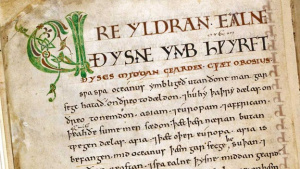Language/Old-english-ca-450-1100/Grammar/Negation
Hi Old English (ca. 450-1100) learners! 😊
In this lesson, we will dive into Old English negation rules. You will learn how to use negation in simple and complex sentences. You will also discover some interesting facts about negation in Old English. This lesson is designed for intermediate learners.
Take a moment to explore these relevant pages as you conclude this lesson: Pronouns, Adjectives & Gender.
Negation in Old English[edit | edit source]
Negation is the opposite of affirmation. In Old English, we use two types of negation: "ne" and "naht". "Ne" comes before the verb, while "naht" comes after the verb. "Ne" negates the action or state of being, while "naht" negates the object. For example:
- "Ic ne eom se cyning" (I am not the king)
- "He naht ne drincð" (He drinks nothing)
Note that "ne" is often omitted in later Old English texts, and "naht" is used exclusively for negation.
Additionally, Old English has negative particles that can be added to the verb to indicate negation. These particles include "na", "ne", "nān", "nā", and "nō". For example:
- "Ne wēne ic" (I do not expect)
- "Nān mǣg man nama dōn" (No one can give a name)
- "Nō wē willað ðæt he cume" (We do not want him to come)
In complex sentences, negation can be used multiple times to express different kinds of negation. For instance:
- "Hē nānne mann ne ondrǣdeð, and hē nōhwæðer ne lufað nāðer ne Gode ne mannum" (He fears no man, and he does not love either God or men)
Negation in Simple Sentences[edit | edit source]
Let's take a look at how to use negation in simple sentences in Old English:
Using "Ne"[edit | edit source]
"Ne" is used to negate the verb in a sentence. It is often contracted with the verb "is" (am, are, is) to form "nis", "næs", and "næron".
| Old English (ca. 450-1100) | Pronunciation | English |
|---|---|---|
| Nis ic ealðeodig. | /nis ik æalðeodiɣ/ | I am not a foreigner. |
| Ne sæcst þu soð. | /ne sæʧst θu soð/ | You do not speak the truth. |
| Ne siȝe ic hēr nǣnne sēlestan cyning. | /ne sijə ik heːr næːnne seːlestɑn kyning/ | I do not see any better king here. |
| Nis ðæt riht. | /nis ðæt rixt/ | That is not right. |
Using "Naht"[edit | edit source]
"Naht" is used to negate the object of a sentence. It is often used with verbs that require an object.
| Old English (ca. 450-1100) | Pronunciation | English |
|---|---|---|
| Hē ne drincð naht. | /heː ne driŋkt næht/ | He does not drink anything. |
| Wǣpen ne genom hē. | /wæːpen neɣenom heː/ | He did not take a weapon. |
| Ne onwreah hē nāðor his tungan nē his mōd. | /ne onwreɑx heː næːdor his tuŋɑn neː his moːd/ | He did not reveal either his tongue or his mind. |
| Næfde hē naht swīðor gefēran. | /nævdə heː næht swiːðor jeveːrɑn/ | He did not have any better companions. |
Negation in Complex Sentences[edit | edit source]
In complex sentences, negation can be used multiple times to express different kinds of negation. For instance:
| Old English (ca. 450-1100) | Pronunciation | English |
|---|---|---|
| Hē nānne mann ne ondrǣdeð, and hē nōhwæðer ne lufað nāðer ne Gode ne mannum. | /heː næːnne mɑn ne ondræːdeð, ɑnd heː noːhwæðer ne luɑvɑð næːðer ne gode ne mɑnnum/ | He fears no man, and he does not love either God or men. |
| Hīe æfre ne gesēoð mid ēagan þā swētestan geþincð. | /hiːe ævre ne je seoð mid æaɣɑn θɑː sweːtestɑn jeθinxt/ | They never see with their eyes what seems sweetest. |
| Hē nōhwæðer ne ēacnode nē mid worde nē mid dǣde þæt hē āgēanes Gode sǣde. | /heː noːhwæðer ne jeɑknode næɑ mid wordə næθ mid dæːde θæt heː ɑːjeɑnes gode sæde/ | He did neither acknowledge with words nor with deeds that he spoke against God. |
Note that in complex sentences, the order of negation can vary according to the requirements of the context.
Interesting Facts[edit | edit source]
- Negation is a common feature of Germanic languages, but Old English is unique in using "naht" to negate the object of a sentence. - The use of "ne" declined over time, while the use of "naht" increased. This shows the transformation of negation in Old English. - Negation was used not only in language but also in runes. Opposite to the rune for "rad", which means ride, the rune for "no ride" had a mirrored image of "rad" to signify negation.
To improve your Old English (ca. 450-1100) Grammar, you can also use the Polyglot Club website. Find native speakers and ask them any questions!
➡ If you have any questions, please ask them in the comments section below.
➡ Feel free to edit this wiki page if you think it can be improved. 😎
Sources[edit | edit source]
- Old English grammar
- Negation in Germanic languages
- Runes
- History of the English language
- English modal verbs
Other Lessons[edit | edit source]

